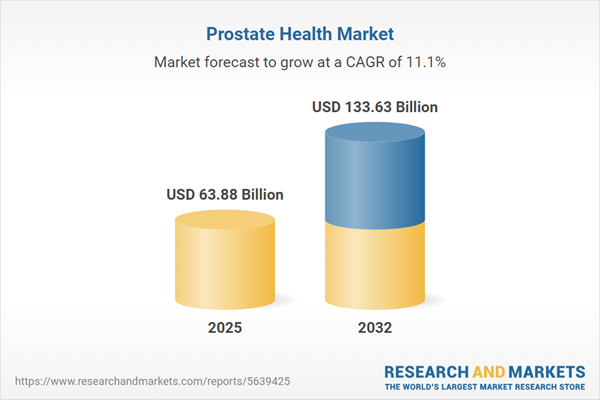Speak directly to the analyst to clarify any post sales queries you may have.
The prostate health market is rapidly evolving, presenting new opportunities and operational challenges for senior decision-makers. Advances in patient-focused technologies, shifts in regulatory landscapes, and increased collaboration across life sciences are redefining how organizations approach patient management, market entry, and overall growth strategies.
Market Snapshot: Prostate Health Market Size and Growth
In 2024, the global prostate health market is valued at USD 57.48 billion, with expectations to reach USD 63.88 billion in 2025 and expand to USD 133.63 billion by 2032. This expansion reflects a compound annual growth rate of 11.12%. Driving this robust trajectory are factors such as broadening patient demographics, expanded access to advanced diagnostics and therapeutic modalities, and continuous innovation in precision healthcare. A competitive landscape persists as leading players leverage personalized medicine and biomarker-driven approaches, which sharpen clinical decision-making and streamline healthcare integration throughout the sector.
Scope & Segmentation: Core Drivers of the Prostate Health Market
Designed for senior leaders overseeing prostate health portfolios, this market intelligence report details foundational segments, emerging opportunity spaces, and evolving compliance factors shaping sector growth and operational strategy.
- Product Types: Diagnostics, pharmaceuticals, and imaging systems are critical to comprehensive patient management and drive continuous innovation in clinical workflows.
- Diagnostic Kits: Early and accurate detection tools are transforming clinical practice, enabling faster intervention decisions and contributing to improved outcomes.
- Drugs: Chemotherapy options, androgen receptor inhibitors, LHRH agonists, immunotherapies, and radiopharmaceuticals broaden therapeutic possibilities and support targeted, patient-specific treatments.
- Imaging Systems: CT, MRI, PET, and ultrasound platforms support precise clinical assessments and underpin improvements in operational efficiency.
- Indications: Solutions address benign prostatic hyperplasia, prostate cancer, and prostatitis, providing integrated urological management across a spectrum of patient needs.
- End Users: Ambulatory centers, diagnostic laboratories, hospitals, and specialized urology and oncology clinics utilize advanced solutions to optimize care delivery across diverse settings.
- Distribution Channels: Direct sales, hospital pharmacies, online platforms, and retail outlets ensure wide-reaching, compliant access to critical products.
- Technology Types: Digital pathology driven by artificial intelligence, molecular diagnostics such as PCA3 and TMPRSS2-ERG markers, and real-time PCR methods enhance diagnostic accuracy and operational flexibility.
- Geographical Coverage: Regional analysis spans the Americas, Europe, the Middle East and Africa, and Asia-Pacific, reflecting the need for locally tailored strategies within different regulatory and demographic contexts.
- Leading Companies: Organizations such as Astellas Pharma Inc., Pfizer Inc., Johnson & Johnson, Bayer AG, Novartis AG, Ferring International Center S.A., Ipsen S.A., AbbVie Inc., AstraZeneca PLC, and Merck & Co., Inc. are strengthening competitiveness and steering innovation through targeted initiatives.
Key Takeaways for Senior Decision-Makers
- Artificial intelligence is increasingly embedded in digital pathology, enhancing the precision and efficiency of clinical workflows while promoting seamless collaboration between multidisciplinary teams.
- Focused modernization of care delivery emphasizes patient-centric approaches, driven by advancements in treatment modalities and higher expectations for service quality.
- Healthcare providers are prioritizing standardization to streamline prostate disease management, which promotes consistent and efficient care across multiple sites and networks.
- Regional regulatory and infrastructure variations require ongoing strategic assessment and flexible compliance strategies to maintain operational readiness globally.
- Integrating advances across diagnostics, therapies, and digital tools is reinforcing the resilience and adaptability of healthcare providers in this constantly shifting environment.
- Engaging in partnerships with local suppliers and refining sourcing practices enhance supply chain reliability and support alignment with regulatory best practices.
Tariff Impact: Responding to Policy Change
Forthcoming U.S. tariff changes will require organizations to re-evaluate their sourcing and procurement practices. Expanding supplier networks and adopting flexible pricing frameworks will support organizational agility and regulatory adherence as trade policies evolve. Continual regulatory monitoring is essential to ensure timely alignment of procurement strategies.
Methodology & Data Sources
This analysis combines executive interviews, in-depth reviews of both peer-reviewed and proprietary studies, and vigilant tracking of regulatory shifts around the globe. The methodology is designed to ensure that insights are relevant, actionable, and directly responsive to leadership priorities in the prostate health sector.
Why This Report Matters
- Informs decision-makers with data-driven insights, strengthening their agility in navigating prostate health market trends and operational imperatives.
- Integrates technology and compliance analysis with strategic priorities, supporting effective risk management and adaptable portfolio oversight.
- Prepares organizations to address changes in supply chain, retail, and policy landscapes, enhancing operational flexibility and sector responsiveness.
Conclusion
This report is an essential resource for senior leaders aiming to navigate change in the prostate health market, empowering informed decisions and revealing new pathways for strategic organizational advancement.
Additional Product Information:
- Purchase of this report includes 1 year online access with quarterly updates.
- This report can be updated on request. Please contact our Customer Experience team using the Ask a Question widget on our website.
Table of Contents
3. Executive Summary
4. Market Overview
7. Cumulative Impact of Artificial Intelligence 2025
Companies Mentioned
The companies profiled in this Prostate Health market report include:- Astellas Pharma Inc.
- Pfizer Inc.
- Johnson & Johnson
- Bayer AG
- Novartis AG
- Ferring International Center S.A.
- Ipsen S.A.
- AbbVie Inc.
- AstraZeneca PLC
- Merck & Co., Inc.
Table Information
| Report Attribute | Details |
|---|---|
| No. of Pages | 183 |
| Published | November 2025 |
| Forecast Period | 2025 - 2032 |
| Estimated Market Value ( USD | $ 63.88 Billion |
| Forecasted Market Value ( USD | $ 133.63 Billion |
| Compound Annual Growth Rate | 11.1% |
| Regions Covered | Global |
| No. of Companies Mentioned | 11 |









